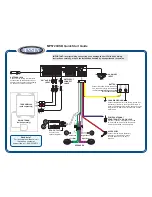
Technical Description of TANDBERG 8000 with software version E3/B8
D12008 Rev. 11
19
Description of PRI Alarms
A PRI cable consists of four wires (two pairs of wires): One pair for Transmit (TX) and one pair
for Receive (RX) signals.
Red Alarm
Red alarm or
Loss of signal (LOS)
means that there is no signal and thus no framing info
received. (This has same effect as pulling out the PRI cable).
Yellow Alarm
Yellow alarm or
Remote Alarm Indicator (RAI)
means that the TANDBERG system is receiving
framing info, but in this framing info the other side tells the system that it is not reading the
system’s transmitted framing info. Typically, this may be a broken connector in the TX part of
the system PRI cable. This could also indicate weak or noisy signal in the TX part of the system
PRI cable.
Blue Alarm
Blue alarm means that network on the far side of the CSU is unavailable.
Scenario: TANDBERG codec is connected via a CSU (i.e. a NT ‘Network Termination’) as
follows:
Codec
–cableA–CSU–cableB–Network
If a CSU loses framing/sync from the network (example: a bad cable B), it shall no longer send
valid framing out on cable A towards the codec. Instead it transmits "Blue Alarm". Seen from a
codec receiving blue alarm, this means that the network on the far side of the CSU is
unavailable.
4.1.1.2
Leased Line E1/T1
The TANDBERG 8000 has implemented the G.703 ITU standard as a network interface-
Leased Line E1/T1.
When connected to a Leased Line E1 network it is possible to run calls from 64 kbps up to 2
Mbps. When connected to a Leased Line T1 network from 56 kbps up to 1.5 Mbps.
There are two Call Control setting for the Leased Line T1/E1:
•
Manual dial mode is supported on Leased Line E1/T1 (i.e. The green ‘connect’ button must
be pressed to initiate a leased line E1/T1 call).
•
The Auto mode is supported on the Leased Line T1/E1. This allows the systems to
automatically answer an incoming call.
















































